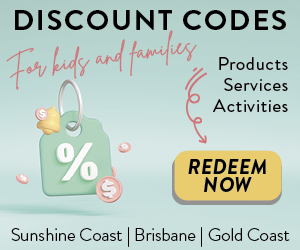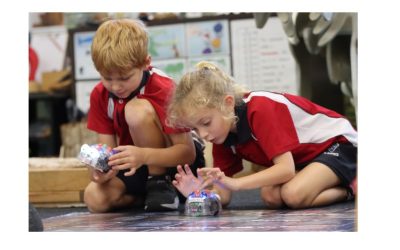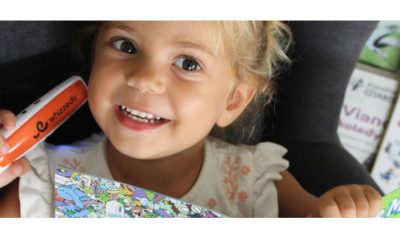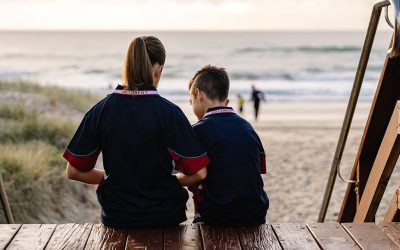With their curious little brains and infinite imaginations, children are play experts. They can turn a cardboard box into a rocket, a dining table into a castle, a walk on the beach into a quest for mermaids.
Though this all might seem like childhood silliness to us blinkered grown-ups, encouraging child-led play is critical for our children’s development.
When children are in charge of their play, the ideas they come up with are usually far better than anything we could ever imagine. And, because a child learns best when they are engaged and focused, this is when the serious learning truly happens.
What is child-led play?
Child-led play is where the child is in charge and they play freely without intervention or direction. Rather than a parent or teacher providing a toy and telling them how it should be played with, the child chooses what they’ll play with, how they play with it, and at what pace.
Coloured blocks are a perfect example of child-led play. One child might stack them into a tower then knock them down, another child might sort them into colours, and another might use them as racing cars. Cardboard boxes are fantastic too. No two children play with the same box in the same way! There’s no right or wrong; each child will explore the toy or activity differently and find their own way to play.
Why is child-led play important?
To truly learn to develop their sense of self, children need time with no adult directed activities. By allowing children to lead the play, we not only support their curiosity and creativity, but also empower them and give them a sense of ownership over their play.
This sense of ownership means they learn to figure things out for themselves, develop innovative ways of solving problems, overcome obstacles and take healthy risks. Children will also have the added satisfaction of pursuing their own creative ideas and owning their achievement.
By following their interests, we remove any unnecessary frustration or pressure for children to learn because they will naturally be engaged in something that they enjoy. And because it interests them, they will ask lots of questions, making the learning a much deeper and more enriching experience.
This engaged and active way of learning is also wonderful for those early literacy skills, opening up opportunities for new vocabulary, conversation and enquiry.
Giving children this space and time to act out situations also provides them with an opportunity to work through emotions in a safe environment, transforming their feelings into actions. When they play collaboratively, children learn to negotiate, share thoughts and communicate feelings, and cooperate and problem solve together.
With time to explore, investigate and experiment, children learn on multiple levels and gain a deeper understanding of the topic. And because they are enjoying themselves, this process fosters a love of learning and nurtures their curiosity. When a child is motivated to learn, nothing can stop them!
A parent’s role in child-led play is easy!
Here comes the best bit! Child-led play can be done anywhere and without any expensive toys or equipment. Other than providing a couple of simple items to help spark an idea, the bulk of the activity is up to the child.
Rather than being the driver, a parent’s biggest role is to be a play ‘wingman’. You are there to answer questions, support them and experience the play alongside them.
If they are struggling to climb a tree, encourage them to persevere. If they can’t remember a word, give them time to find another word rather than jumping in and answering for them. Try not to focus on the ‘correct’ way to do things and curb your desire to step in and help (though this is often the hardest bit!). Instead, simply follow their lead and watch as they discover things for themselves. You are their safe place; with you alongside they will feel secure enough to explore and learn.
As well as giving your frazzled parent brain a break for a moment, by taking a backseat in the day’s activities, you will get the opportunity to watch and observe your child at play. This will give you wonderful insight into how they see the world. Their interests, their thought processes, and what really sparks their imagination.
Most importantly, a parent’s role is simply to laugh, have fun and enjoy the lack of structure for a moment. Knowing that what you are doing (and not doing) is critical to your child’s growth.
Take advantage of free resources
Now that you’ve managed to let go of the structure, you can also tap into a wealth of free resources that make child-led play even easier.
The library website has a huge array of resources to aid in early literacy and play fun. With online Rhymetime and Storytime sessions to foster your little one’s imagination, links to parenting and education resources, videos, games and more, there is a wealth of information available.
If you are stuck for ideas, the library bookshelves are a fabulous place for inspiration. Head to the non-fiction section for books on craft, sport, vehicles, the solar system and more. Your child can explore the topics and borrow several books, allowing you to spark their interest and you can explore the subject together at home. One simple idea can start multiple learning and play opportunities; who knows where it will lead them!
If in doubt, there’s always Bluey
No, this isn’t just about chillaxing in front of the TV together! There is a lot to be learnt from that little blue heeler. Next time it’s TV time for your child, pop on an episode of Bluey and see whether the daily activities of this play-focused family spark some inspiration for your own fun and games.
Great child-led play toys
- Building blocks
- Dress-ups
- A collection of boxes with lids, or bottles and tops
- Toy animals
- Sticks, stones and leaves
- A tub of water and different sized cups, funnels and spoons
- Play-doh
- Puppets
- Mud kitchen
- Pretend play items – doctors kit, picnic set, kitchenette, play food.
You may also like…
Sensory play and its importance in early learning
Early literacy games you can play anytime and anywhere



